-
Posts
821 -
Joined
-
Last visited
-
Days Won
8
Content Type
Profiles
Forums
Blogs
Gallery
Events
Store
Posts posted by Markus
-
-
Very nice nick! I particularly like the illustrations showing the early medals having the Turkish Medjidie influences for design. In Post #3 the author appears to be quoting from a firman or award document translation. Also he refers to the medal as the Sun and Lion as it was first known rather than the Lion and Sun as it was called in later periods. Attaching some of the Spada collection medals that match the illustrations. Seems like the early Sun and Lions faced right rather than left as subsequent Lion and Sun medals.
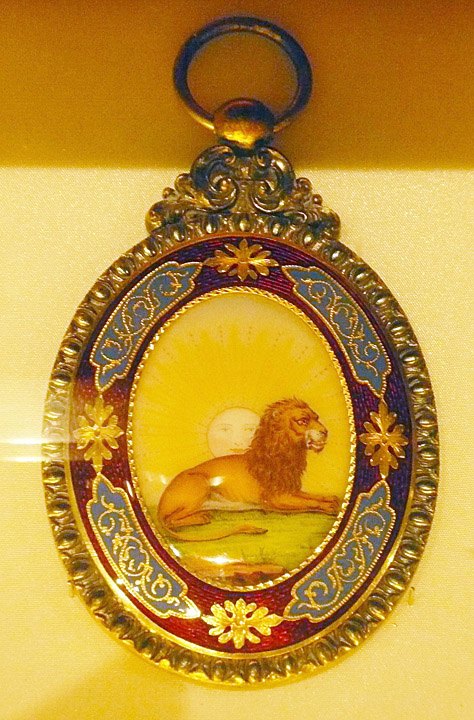 0
0 -
Hi Babar,
Unsure of date painting was made. Time frame would most likely be 1850 to 1865 era. Pulled from Qatar portraits book by Julian Raby.
0 -
Another oil painting portrait of Nasir al-Din Shah with Lion and Sun medal and the the Nishan-i-Tamtal-i-Humayun (Decoration of the imperial portrait) order. Artist of this painting was Abu'l Hasan Ghaffari. in 1842 he was appointed chief painter by Muhammad Shah and sent to Italy and France to study. He returned with a style that combined a new capacity for physical likeness and psychological characterization with a decorative flair that enlivened paintings without compromising their insight. In 1861 the Shah rewarded Abu'l Hasan with the title Sani al-Mulk ( Craftman of the Kingdom) In this era the Shah brought many European influences into Persia and the style of the paintings shifted to realism with a more pronounced western style. Excerpt from Qajar Portraits by Julian Raby.
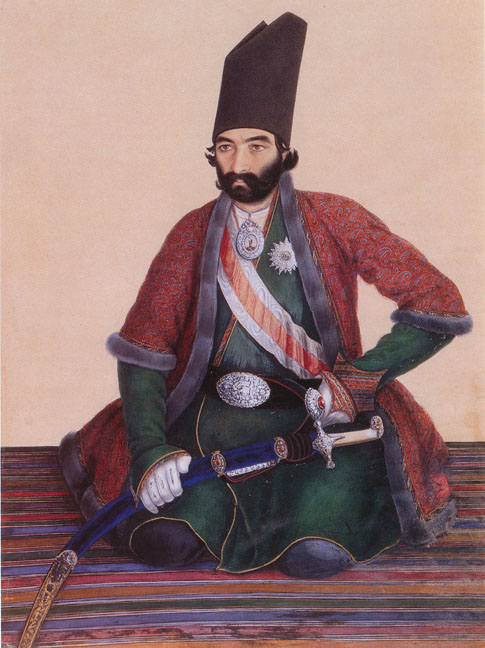 0
0 -
This is a postcard photo taken of Nasir al-Din (1831-1896). Plenty of jewels, however I can't make out if any are order medals. He was the King of Persia from Sept 17,1848 to May 1, 1896, the day he was assassinated. He was the third longest reigning monarch King in Persian History, having sovereign power for close to fifty years. Nasir al-Din Shah brought Persia into the modern age, building modern infrastructure such as roadways, railways, schools and postal system. He was the first modern Persian Shah to visit europe in 1873 and again in 1878. He also was the first Shah to be photographed and had hundreds of portraits made during his reign.
A list of his order medals received shows the history of his interaction with Europe and Russia.
Honours
- Knight of the Order of the White Eagle of Russia-1838
- Grand Cross of the Legion d'Honneur of France-1855
- Grand Cross of the Order of St Stephen of Hungary-1859
- Grand Cross of the Order of Saints Maurice and Lazarus of Italy-1862
- Knight of the Order of the Most Holy Annunciation of Italy-1862
- Grand Cross of the Order of the Netherlands Lion-1868
- Knight of the Order of St. Andrew of Russia-1873
- Knight of the Order of St. Alexander Nevsky of Russia-1873
- Knight of the Order of Saint Stanislaus, 1st Class of Russia-1873
- Knight of the Order of St. Anna, 1st Class of Russia-1873
- Knight of the Order of the Garter (KG)-1873
- Knight of the Order of the Black Eagle of Prussia-1873
- Grand Cross of the Order of the Red Eagle of Prussia-1873
- Grand Cordon of the Order of Leopold of Belgium-1873
- Exalted Order of Honour of Turkey-1880
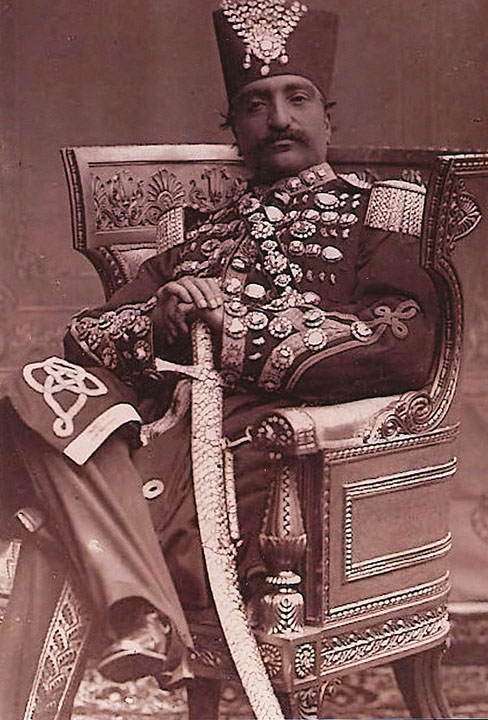 0
0 - Knight of the Order of the White Eagle of Russia-1838
-
Thank you Nick! Absolutely beautiful Russian Lions and Suns! The Russian Jewelers were at the top of their game in that era. Very distinctive silver work as well. It seems like there were as many unknown jewelers today as there are known jewelers. That is a lot of order making jewelers in Russia! Your threads are very informative and a joy to follow.
Markus
0 -
I have always been wondering about the order of Aftab portraits of women who look like men!
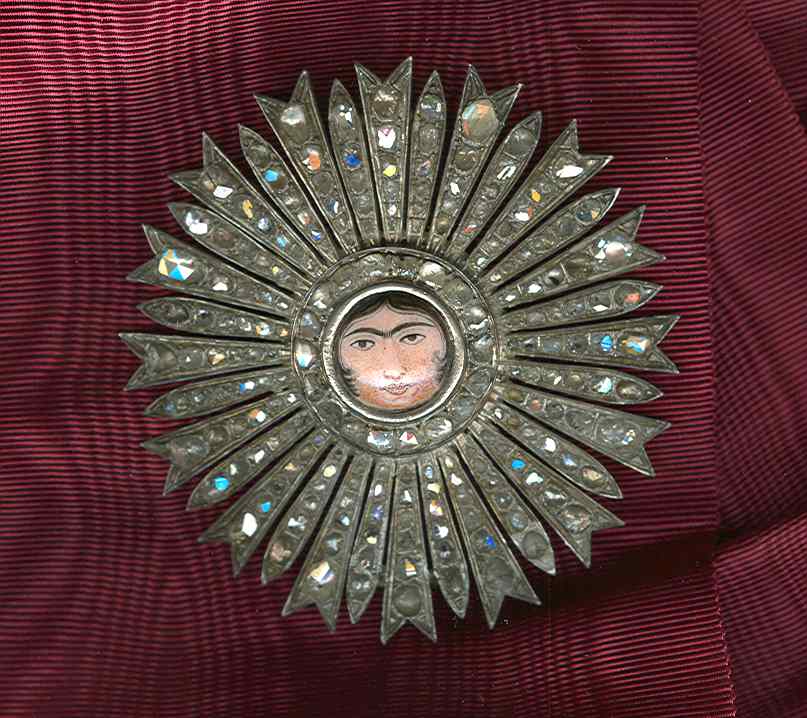
The unibrows,mustaches and beards on women certainly are a special niche of beauty taste.
Louis XIV was also know as the Sun King. Thanks James and Babar for your interesting posts!
Markus
0 -
Thanks James, As Always, your scholarly and intimate knowledge of this order is amazing and deeply appreciated !
Regarding the early book, L. Brasier and J.L. Brunet, Les Ordres Persans, Actualites Diplomatiques & Coloniales, Arthus Bertrand et Beranger, Paris, 1902, are there any digital copies of this book in any libraries? I seem to come up empty searching for an original copy of the book. Did the book have illustrations? Lastly, do you consider this book an accurate source of Persians order history?
Thanks,
Markus
0 -
And now something very interesting, beautiful and very russian

Lion and sun order that was made by Dmitry Osipov in St. Petersburg back in 1899-1904.
Marked with personal mark “ДО” and St. Petersburg county district hallmark.
Size 78,3´60,5mm, weight 39,1 grams.
Enjoy!
Thanks Nick. Very beautiful! Can you give me more info on Dmitry Osipov maker? He wasn't listed in my book " Court Jewelers of the world" Period of time he was a medal maker, other order medals he made, and general reputation as a jeweler of order medals is the kind of info I like. I love the metal work on this order. The radiating lines of spherical shaped silverwork seems unique to Russian, Austrian and some German makers.
0 -
Yes, I think the photographic evidence in the article by Commissary-General Stiot, in the Revue Belge d’Histoire Militaire XVI-7/8, Bruxelles (1966), shows very different insignia for the Order of the Sun. Not only the central design with a depiction of the sun, without lion, but also the overall shape and design of the badge - a six-armed enamelled star in the shape of flower petals. See #161
The Order of the Sun seems to have fallen into disuse sometime in the 1820's. Up to the early 1820's there are a few reports in the memoirs of European officers who served in the Persian army, about the Crown Prince Abbas Mirza making the odd award, but nothing after 1826.
Cheers,
James
Yes, I would have to agree. If the Persians could convince Sir John Malcolm that the orders ot the Sun and order of the Lion and Sun were two different orders (and he accepted it without protest given his abhorrence to accepting the same award as his enemy), the historians should also accept that the two orders were separate orders.
Markus
0 -
Thank you Markus. One of the things that baffles me is the quality of enamel center piece of Russian manufactures. The quality of workmanship on the silver medal and the attached rays is remarkable however the center painting leaves more to be desired. Is that just me? I would have expected for such beautiful bling pieces that the center lion be a bit more regal looking.
Yes Barbar, I agree with you in this case, however there have been many Russian makers with all different styles of medallion paintings. I believe posts #21 and #43 were both Russian made and are of incredible beauty! Some of the Russian made medallion paintings are difficult to tell the difference from the Persian made ones.
Markus
0 -
This was a beautiful set of jeweled Russian made Commander badge and Breast star up for auction on Galerie Numastique XV auction. The pieces had Russian hallmarks but no makers names. The starting price was 9000 Euro, and it appears to have gone unsold, with no final listing price in realized prices document. The jewels were paste stones.
 0
0 -
Something nice from Germany.
Codet, Berlin.
Siver, marked 800.
Size 110´65mm
Unfortunately no photo of reverse.
Very nice Nick! This commander badge is most unusual in that it has eight green rays. Most of the commander badges have six rays and usually eight rays are reserved for 1st class badges. Was this beauty sold in auction? Godet (Berlin) is an extremely rare maker of this order. I have only seen one other on Najaf's site, a 2nd class breast star.
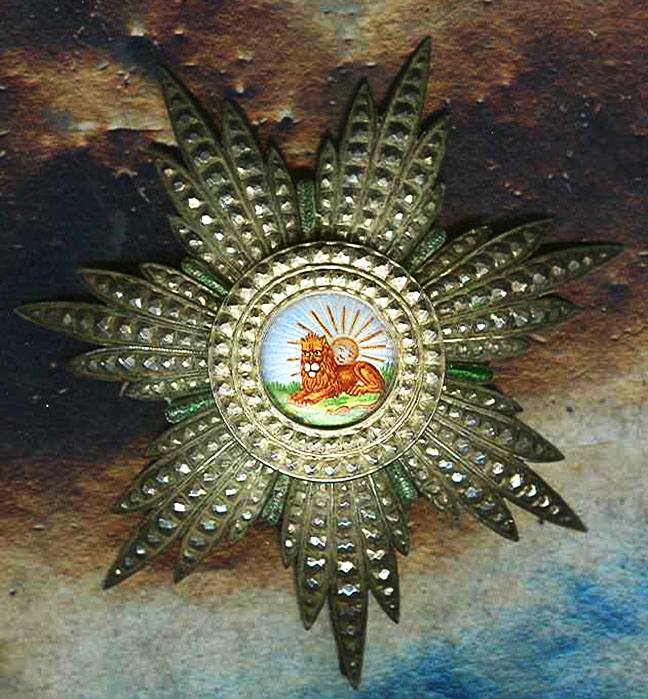 0
0 -
There is in fact slightly more detail on Telleyrand's order.
It seems that his insignia with the Lion and Sun was received after 1820/1826, by which time the Order of the Sun had ceased to be awarded. The Lion and Sun was probably a new award. Although, it is quite possible that due to the Napoleonic Wars his orginal insignia of the Order of the Sun may have never never actually been dispatched to him or was lost in transit.
It may be an idea when referring to recipients to use their full names, e.g. Sir John Malcolm not 'Sir Malcolm' and Sir John Kinnear Macdonald not 'Sir John Macdonald'. With an order that was bestowed in such great numbers, it may otherwise cause much confusion to the average reader.
Cheers,
James
Very nice points James. I have changed my references to full names. So the later issuance of Talleyrand's order would be the reason his order contained both lion and sun. That fact supports the theory of two separate orders. So few of the Order of the Sun medals were awarded it seems.
Markus
0 -
I am confused about one thing. In the "Royal Persian Paintings", it states that this order of lion and sun (One Nick posted #162) was singed by "Muhammad Jafar" and dated 1828. Then how can Sir Malcolm receive this in 1810? What am i missing?

Yes you are right Babar! I saw this order illustrated in the Sir John Malcolm article and didn't read the fine print attributing it to Sir John Kinneir Macdonald in 1828. Sorry my bad and good catch!
Markus
0 -
Close up #3 Sir John Kinneir Macdonald's Lion and Sun Order presented in 1828.
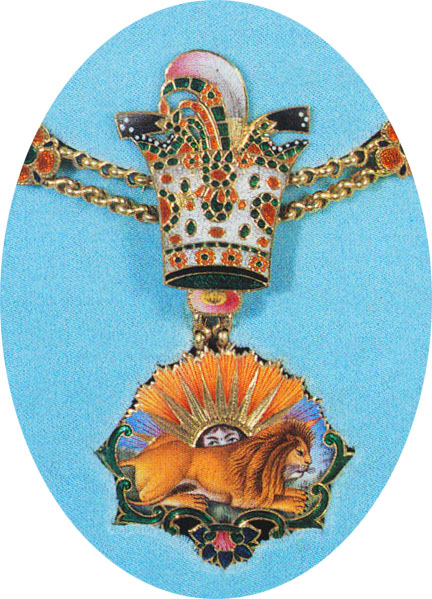 0
0 -
Close up #2 Sir John Kinneir Macdonald's Lion and Sun Order presented in 1828.
 0
0 -
Close up #1 Sir John Kinneir Macdonald's Lion and Sun Order presented in 1828.
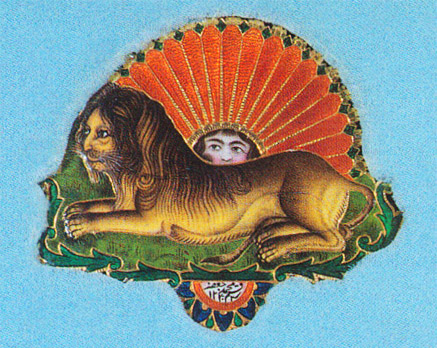 0
0 -
Sir John Kinneir Macdonald's Lion and Sun Order presented to him in 1828. It is most interesting to note that the Order of the Lion and Sun presented to Sir John Kinneir Macdonald contains prototype artwork also utilized later in Persia’s order of Aftab, an order founded in 1873 by Nasser al-Din Shah to award female sovereigns or consorts of reining rulers
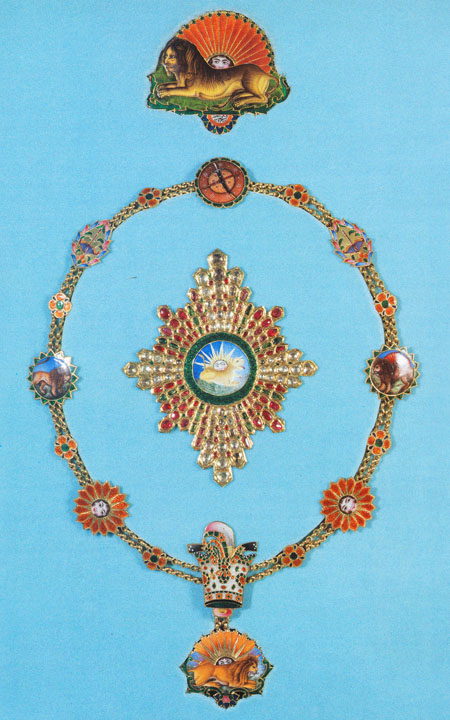 0
0 -
First let me say that without James Hoard & Nicks contributions, I would have never seen the source articles for this post. The information sources were two papers by British Institute of Persian Studies, The Order of the Lion and Sun by Denis Wright and Sir John Malcolm and the Order of the Lion and Sun by Denis Wright. These were listed initially as sources by James Hoard and I owe Nick a huge thank you for forwarding the original articles to me.
The birth of the Persian Lion Sun Order started off as the Order of The Sun around 1807 modeled after the French Legion of Honor. Before this time the Persians did not have order medals and it is thought that the interaction with the Europeans created a desire and a need for an order medal. Napoleon I, French General Trézel, and French General Gardane were awarded the Order of the Sun by Persia featuring a rising sun. The black and white image attached shows the order of the Sun that was presented to Napoleon I. In 1908 Charles Maurice de Talleyrand, Former French Minister of Foreign Affairs, is honored by Persia with the same Order of the Sun, except Talleyrand’s order had depictions of the lion and sun together on both his badge and breast star.
In 1810 Sir John Malcolm of Great Britain receives a newly created order of the Lion and Sun for his efforts in building an alliance between Britain and Persia. At first the Shah wanted to honor Sir John Malcolm with the same order he had presented to the French General Gardane, the Order of the Sun. Sir John Malcolm refused to be awarded the Order of the Sun, since it would be unloyal and unbecoming to accept an award that had been instituted for the benefit of an enemy. It was suggested that a new order be instituted, resulting in the Order of the Lion and Sun being created by the court jeweler. The distinctions between the two orders were pressed on Sir John Malcolm and Sir John Malcolm acquiesced, gratefully accepting the new order of the Lion and Sun.
Early on in history, French publications and British publications differed in opinion as to the whether two separate orders existed, The Order of Lion and Sun and The Order of The Sun, or that both orders were simply different manifestations of the Order of Lion and Sun. After 1841, French publications no longer made distinctions between the two types of medals and called all the early issued medals Order of the Lion and Sun. However, other historians maintain that the orders were indeed two separate orders. So the Order of the Lion and Sun was greatly influenced by the interaction with and demands of European governments.
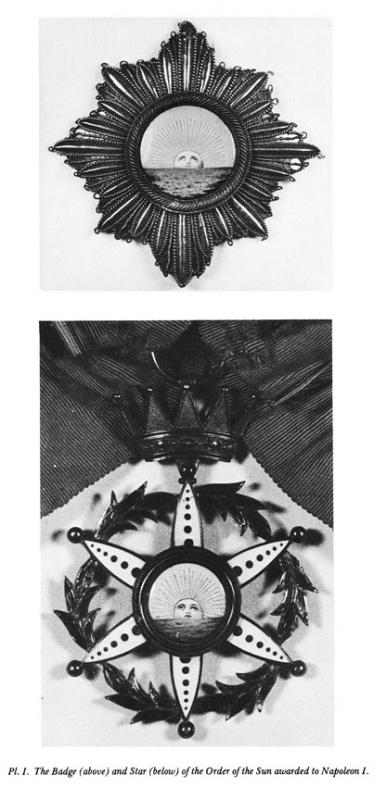 0
0 -
AHHHHHHH! James and Nick! I really like the contributions from both of you and find these tit for tat posts unrewarding and sort of unprofessional. To me it doesn't much matter who the original source was, what matters is getting the information and history of these orders. I have received some great information, links and history from both of you. To quote Rodney King: "Can't we all just get along?"
:unsure:
0 -
That Is the beauty of this order! The hand painted medallions were all done by different artists, reflecting the skill and taste of the individual artist. Even in some of the European made medals, the medallions will vary, depending on which artist created the medallion painting. I really like the early Persian made medallions for their sheer artistry. Thanks Babar & Nick for all your contributions.
Attached is the front of Faiz Allah medal from Babar's previous posting of Persian name plate.
Markus
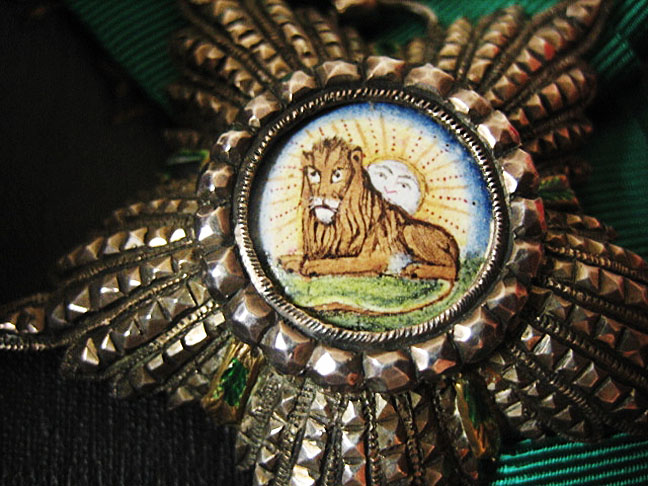 0
0 -
Thanks Babar, good to know! So the one I have is Definetely not a Faiz Allah. Does the Mashashahi jewelery house translation still look good? Do you have the enamel painting on the front of this order to show the Faiz Allah style painting? This maker's mark is a beauty!
0 -
Love all the additional history on this order! Thank Gavin and Nick!
Markus
0 -
The numbers of Lion and Sun orders ballooned to such a degree that the royal Firman painters couldn't keep up or the beautiful hand painted Firmans were reserved for heads of state is my guess. Very nice thread Nick. You certainly do have excellent research skills and access to a wealth of material that the non-Russian speakers are excluded from. Seems like Persia and Russia have had a lot of interaction in their history.
0




Sir Bernard Burke on Lion and Sun Order
in Middle East & Arab States
Posted
This was an early Sun and Lion medal presented to Napoleon III that was exhibited in LOH museum in Paris for sometime. Do not know if it is still there. The Lion is also facing right.